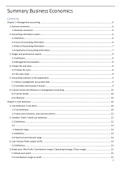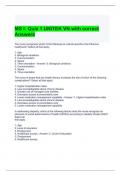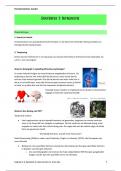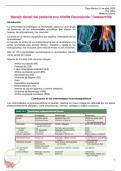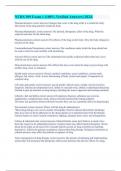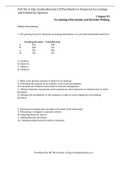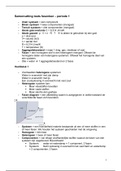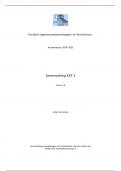Summary Business Economics
Contents
Chapter 1: Management accounting ................................................................................................................................ 6
1. Business economics .................................................................................................................................................. 6
1.1 Business economics ............................................................................................................................................ 6
2. Accounting information system ................................................................................................................................ 6
2.1 Definition............................................................................................................................................................. 6
2.2 Users of accounting information ........................................................................................................................ 6
2.3 Roles of Accounting information ........................................................................................................................ 7
2.4 Importance of accounting information ............................................................................................................... 7
3. Budget and performance reports ............................................................................................................................. 8
3.1 Definitions ........................................................................................................................................................... 8
3.2 Management by exception ................................................................................................................................. 8
4. Product life and value ............................................................................................................................................... 8
4.1 Product life cycle ................................................................................................................................................. 8
4.2 The value chain ................................................................................................................................................... 9
5. Accounting’s position in the organisation ................................................................................................................ 9
5.1 What a management accountant does............................................................................................................... 9
5.2 Controller and treasurer function ....................................................................................................................... 9
6. Current trends and influences in management accounting ................................................................................... 10
6.1 Current trends ................................................................................................................................................... 10
6.2 Influences .......................................................................................................................................................... 10
Chapter 2: Cost behaviour .............................................................................................................................................. 10
1. Cost behaviour / Cost driver ................................................................................................................................... 10
1.1 Cost behaviour .................................................................................................................................................. 10
1.2 Value chain functions, costs and cost drivers ................................................................................................... 12
2. Variable / Fixed / mixed cost behaviour ................................................................................................................. 12
2.1 Definitions ......................................................................................................................................................... 12
2.2 ........................................................................................................................................................................... 13
3. Relevant range ................................................................................................................................................... 13
3.1 Definition........................................................................................................................................................... 13
3.2 Fixed cost and relevant range ........................................................................................................................... 14
4. Cost-Volume-Profit analysis (CVP) .......................................................................................................................... 14
4.1 Definitions ......................................................................................................................................................... 14
5. Break-even / Net Profit / Contribution margin / Operating leverage / Gross margin ............................................ 15
5.1 Break-even point ............................................................................................................................................... 15
5.2 Contribution margin vs profit............................................................................................................................ 15
1
, 5.3 How to determine the break-even point? ........................................................................................................ 15
5.4 Target Net profit ............................................................................................................................................... 16
5.5 Operating leverage............................................................................................................................................ 16
5.6 Gross margin vs Contribution margin ............................................................................................................... 16
Chapter 3: Cost Functions ............................................................................................................................................... 16
1. Cost drivers and cost behaviour.............................................................................................................................. 16
1.1 Linear cost behaviour ........................................................................................................................................ 16
1.2 Management’s influence on cost behaviour .................................................................................................... 17
2. Capacity Decisions / Committed fixed costs / Discretionary fixed costs ................................................................ 17
2.1 Capacity decisions ............................................................................................................................................. 17
2.2 Committed fixed costs ...................................................................................................................................... 17
2.3 Discretionary fixed costs ................................................................................................................................... 17
2.4 Examples of committed and discretionary fixed costs ..................................................................................... 18
5. Technology decisions / cost-control incentives ...................................................................................................... 18
5.1 Technology decisions ........................................................................................................................................ 18
5.2 Cost-control incentives ..................................................................................................................................... 18
6. Control functions .................................................................................................................................................... 18
6.1 Usage ................................................................................................................................................................. 18
6.2 Cost function equation...................................................................................................................................... 19
6.3 Developing cost functions ................................................................................................................................. 19
6.4 Choice of cost drivers: activity analysis............................................................................................................. 19
7. Methods of measuring cost functions .................................................................................................................... 19
7.1 Engineering analysis .......................................................................................................................................... 19
7.2 Account analysis ................................................................................................................................................ 19
Chapter 4: Cost Allocation .............................................................................................................................................. 20
1. Costs ........................................................................................................................................................................ 20
1.1 Cost management system ................................................................................................................................. 20
1.2 Cost ................................................................................................................................................................... 20
1.3 Cost object ........................................................................................................................................................ 20
1.4 Cost accounting system .................................................................................................................................... 21
1.5 Direct and indirect costs ................................................................................................................................... 21
1.6 Cost allocation ................................................................................................................................................... 21
1.7 Cost assignment ................................................................................................................................................ 21
1.8 Cost pool ........................................................................................................................................................... 22
1.9 Unallocated costs .............................................................................................................................................. 22
1.10 Statement of operating income ...................................................................................................................... 22
2. Categories of manufacturing costs ......................................................................................................................... 22
2.1 Definition........................................................................................................................................................... 22
2
, 2.2 Direct materials ................................................................................................................................................. 23
2.3 Direct labour costs ............................................................................................................................................ 23
2.4 Indirect production costs (Manufacturing overhead)....................................................................................... 23
3. Types of costing systems......................................................................................................................................... 23
3.1 Traditional costing system ................................................................................................................................ 23
3.2 Activity-based costing system (ABC) ................................................................................................................. 24
3.3 Steps to the ABC system ................................................................................................................................... 25
Chapter 5: Pricing decisions ............................................................................................................................................ 26
1. Relevance ................................................................................................................................................................ 26
1.1 The concept of relevance .................................................................................................................................. 26
1.2 Decision model .................................................................................................................................................. 27
1.3 Accuracy and relevance .................................................................................................................................... 28
1.4 Relevance of income statements ...................................................................................................................... 28
2. Absorption an Contribution approach .................................................................................................................... 28
2.1 Absorption costing ............................................................................................................................................ 28
2.2 Contribution costing.......................................................................................................................................... 29
2.3 Comparing Absorption and contribution approaches ...................................................................................... 29
3. Special sales order................................................................................................................................................... 29
3.1 Example ............................................................................................................................................................. 29
4. Incorrect analysis: Misuse of unit cost .................................................................................................................... 30
4.1 Example ............................................................................................................................................................. 30
5. Activity-based costing, special orders, and relevant costs ..................................................................................... 30
5.1 Example ............................................................................................................................................................. 30
6. Influences on pricing in practice ........................................................................................................................ 31
6.1 Cost-plus pricing................................................................................................................................................ 31
6.2 Target costing.................................................................................................................................................... 31
Chapter 8: Budgeting ...................................................................................................................................................... 32
1. Budgeting terms ...................................................................................................................................................... 32
1.1 Favourable & unfavourable variances .............................................................................................................. 32
2. Static and flexible Budgets ...................................................................................................................................... 32
2.1 Static budgets.................................................................................................................................................... 32
2.2 Flexible budgets ................................................................................................................................................ 32
2.3 Activity-based flexible budget........................................................................................................................... 32
2.4 Static-budget variances and flexible-budget variances .................................................................................... 34
2.5 Flexible-budget variances ................................................................................................................................. 34
2.6 Sales-activity variances ..................................................................................................................................... 34
3. Standards in variance .............................................................................................................................................. 34
3.1 Role of standards in determining variances...................................................................................................... 34
3
, 3.2 Setting standards .............................................................................................................................................. 34
3.3 Currently attainable standards ......................................................................................................................... 34
4. Trade-offs ................................................................................................................................................................ 34
4.1 Definition........................................................................................................................................................... 34
5. Investigating variances ............................................................................................................................................ 35
5.1 When to investigate .......................................................................................................................................... 35
5.2 Isolating the causes of variances ...................................................................................................................... 35
5.3 Comparison with prior periods ......................................................................................................................... 35
6. Flexible-budget variance in detail (Direct variable costs) ....................................................................................... 35
6.1 Variances for material and labour standards.................................................................................................... 35
6.2 Price and quantity variances ............................................................................................................................. 36
6.3 Quantity (usage) variance computations .......................................................................................................... 36
6.4 Price variance computations ............................................................................................................................. 37
6.5 Direct materials flexible budget ........................................................................................................................ 37
6.6 Interpretation of price and quantity variances ................................................................................................. 37
7. Variable-overhead variances (Indirect variable costs) ............................................................................................ 37
7.1 Spending / efficiency variances......................................................................................................................... 37
8. Fixed-overhead spending variance (Fixed costs) .................................................................................................... 37
Chapter 16: Financial Statements ................................................................................................................................... 38
1. What and for who? ................................................................................................................................................. 38
1.1 For who? ........................................................................................................................................................... 38
1.2 What? ................................................................................................................................................................ 38
2. Balance sheet .......................................................................................................................................................... 38
2.1 Definition........................................................................................................................................................... 38
3. Operating cycle ....................................................................................................................................................... 38
3.1 Definition........................................................................................................................................................... 38
4. Classified balance sheet: assets section.................................................................................................................. 39
4.1 Cash equivalents ............................................................................................................................................... 39
4.2 Short-term investments .................................................................................................................................... 39
4.3 Accounts receivable .......................................................................................................................................... 39
4.4 Inventories ........................................................................................................................................................ 40
4.5 Prepaid expenses and other current assets ...................................................................................................... 40
4.6 Noncurrent assets: property, plant and equipment ......................................................................................... 40
4.7 Depreciation ...................................................................................................................................................... 41
4.8 Intangible assets................................................................................................................................................ 41
5. Classified balance sheet: Liabilities section ............................................................................................................ 41
5.1 Current liabilities ............................................................................................................................................... 41
5.2 Working capital ................................................................................................................................................. 42
4
, 5.3 Noncurrent liabilities......................................................................................................................................... 42
5.4 Stockholders’ equity.......................................................................................................................................... 42
5.5 Common and preferred stock ........................................................................................................................... 42
5.6 Retained earnings and other comprehensive income ...................................................................................... 43
5.7 Treasury stock ................................................................................................................................................... 43
5.8 Income statement ............................................................................................................................................. 43
5.9 Revenues and expenses .................................................................................................................................... 43
5.9 Income, Earnings and profit .............................................................................................................................. 44
6. Financial management ............................................................................................................................................ 44
6.1 Definition........................................................................................................................................................... 44
7. Statement of changes in stockholders’ equity ........................................................................................................ 44
7.1 Explaining changes ............................................................................................................................................ 44
8. Relationship between balance sheet and income statement ........................................................................... 45
9. The analytical power of the balance sheet equation.............................................................................................. 45
9.1 What? ................................................................................................................................................................ 45
10. Annual reports ...................................................................................................................................................... 45
10.1 Definition......................................................................................................................................................... 45
Chapter 17: Analysing financial statements ................................................................................................................... 45
1. How to analyse financial statements ...................................................................................................................... 45
1.1 What is analysing financial statements............................................................................................................. 45
1.2 Component percentages ................................................................................................................................... 46
1.3 Uses of ratios..................................................................................................................................................... 46
2. Time- series comparisons........................................................................................................................................ 47
2.1 What? ................................................................................................................................................................ 47
3. Nike overview.......................................................................................................................................................... 47
3.1 Balance sheet .................................................................................................................................................... 47
3.2 Income statement ............................................................................................................................................. 48
5
,Chapter 1: Management accounting
1. Business economics
1.1 Business economics
• Part of economics
o Unlimited needs versus limited resources (scarcity and choice)
o Main objective: maximum profit with minimum use of resources
• This principle applied within business organisations
• Resources are anything you use within your company, such as raw material, personnel, fixed assets, time
• Which decisions do we need to make?
• If we USE resources, we get COSTS
o A cost can be seen as the translation of the usage of a resource
2. Accounting information system
2.1 Definition
• An accounting system is a formal mechanism for gathering, organizing, and communicating information
about an organization’s activities
• In order to reduce costs and complexity, many organizations use a general-purpose accounting system that
attempts to meet the needs of both external and internal users
2.2 Users of accounting information
6
, 2.3 Roles of Accounting information
• Scorekeeping
o Evaluate organizational performance
• Attention directing
o Compare actual results to expected
• Problem solving
o Assess possible courses of action
2.4 Importance of accounting information
• Accounting information is used in decision making for planning and control
o Planning describes how the organization will achieve its objectives
o Control is the process of implementing plans and evaluating if objectives are achieved
7
, 3. Budget and performance reports
3.1 Definitions
• Budget
o quantitative expression of a plan of action
• Performance reports
o compare actual results with budgeted amounts
o provide feedback by comparing results with plans
o highlight variances
o Example:
• Variances
o deviations from plans
3.2 Management by exception
• Concentrating more on areas that deviate from the plan and less on areas that conform with plans and are
presumed to be running smoothly
o PRO:
▪ Frees managers from needless concern with those phases of operations that adhere to plans
and are running smoothly
▪ More focused
o Contra
▪ Attention should be given to products/services which are actually operating well.
4. Product life and value
4.1 Product life cycle
• Product life cycle refers to the various stages through which a product passes
8
Contents
Chapter 1: Management accounting ................................................................................................................................ 6
1. Business economics .................................................................................................................................................. 6
1.1 Business economics ............................................................................................................................................ 6
2. Accounting information system ................................................................................................................................ 6
2.1 Definition............................................................................................................................................................. 6
2.2 Users of accounting information ........................................................................................................................ 6
2.3 Roles of Accounting information ........................................................................................................................ 7
2.4 Importance of accounting information ............................................................................................................... 7
3. Budget and performance reports ............................................................................................................................. 8
3.1 Definitions ........................................................................................................................................................... 8
3.2 Management by exception ................................................................................................................................. 8
4. Product life and value ............................................................................................................................................... 8
4.1 Product life cycle ................................................................................................................................................. 8
4.2 The value chain ................................................................................................................................................... 9
5. Accounting’s position in the organisation ................................................................................................................ 9
5.1 What a management accountant does............................................................................................................... 9
5.2 Controller and treasurer function ....................................................................................................................... 9
6. Current trends and influences in management accounting ................................................................................... 10
6.1 Current trends ................................................................................................................................................... 10
6.2 Influences .......................................................................................................................................................... 10
Chapter 2: Cost behaviour .............................................................................................................................................. 10
1. Cost behaviour / Cost driver ................................................................................................................................... 10
1.1 Cost behaviour .................................................................................................................................................. 10
1.2 Value chain functions, costs and cost drivers ................................................................................................... 12
2. Variable / Fixed / mixed cost behaviour ................................................................................................................. 12
2.1 Definitions ......................................................................................................................................................... 12
2.2 ........................................................................................................................................................................... 13
3. Relevant range ................................................................................................................................................... 13
3.1 Definition........................................................................................................................................................... 13
3.2 Fixed cost and relevant range ........................................................................................................................... 14
4. Cost-Volume-Profit analysis (CVP) .......................................................................................................................... 14
4.1 Definitions ......................................................................................................................................................... 14
5. Break-even / Net Profit / Contribution margin / Operating leverage / Gross margin ............................................ 15
5.1 Break-even point ............................................................................................................................................... 15
5.2 Contribution margin vs profit............................................................................................................................ 15
1
, 5.3 How to determine the break-even point? ........................................................................................................ 15
5.4 Target Net profit ............................................................................................................................................... 16
5.5 Operating leverage............................................................................................................................................ 16
5.6 Gross margin vs Contribution margin ............................................................................................................... 16
Chapter 3: Cost Functions ............................................................................................................................................... 16
1. Cost drivers and cost behaviour.............................................................................................................................. 16
1.1 Linear cost behaviour ........................................................................................................................................ 16
1.2 Management’s influence on cost behaviour .................................................................................................... 17
2. Capacity Decisions / Committed fixed costs / Discretionary fixed costs ................................................................ 17
2.1 Capacity decisions ............................................................................................................................................. 17
2.2 Committed fixed costs ...................................................................................................................................... 17
2.3 Discretionary fixed costs ................................................................................................................................... 17
2.4 Examples of committed and discretionary fixed costs ..................................................................................... 18
5. Technology decisions / cost-control incentives ...................................................................................................... 18
5.1 Technology decisions ........................................................................................................................................ 18
5.2 Cost-control incentives ..................................................................................................................................... 18
6. Control functions .................................................................................................................................................... 18
6.1 Usage ................................................................................................................................................................. 18
6.2 Cost function equation...................................................................................................................................... 19
6.3 Developing cost functions ................................................................................................................................. 19
6.4 Choice of cost drivers: activity analysis............................................................................................................. 19
7. Methods of measuring cost functions .................................................................................................................... 19
7.1 Engineering analysis .......................................................................................................................................... 19
7.2 Account analysis ................................................................................................................................................ 19
Chapter 4: Cost Allocation .............................................................................................................................................. 20
1. Costs ........................................................................................................................................................................ 20
1.1 Cost management system ................................................................................................................................. 20
1.2 Cost ................................................................................................................................................................... 20
1.3 Cost object ........................................................................................................................................................ 20
1.4 Cost accounting system .................................................................................................................................... 21
1.5 Direct and indirect costs ................................................................................................................................... 21
1.6 Cost allocation ................................................................................................................................................... 21
1.7 Cost assignment ................................................................................................................................................ 21
1.8 Cost pool ........................................................................................................................................................... 22
1.9 Unallocated costs .............................................................................................................................................. 22
1.10 Statement of operating income ...................................................................................................................... 22
2. Categories of manufacturing costs ......................................................................................................................... 22
2.1 Definition........................................................................................................................................................... 22
2
, 2.2 Direct materials ................................................................................................................................................. 23
2.3 Direct labour costs ............................................................................................................................................ 23
2.4 Indirect production costs (Manufacturing overhead)....................................................................................... 23
3. Types of costing systems......................................................................................................................................... 23
3.1 Traditional costing system ................................................................................................................................ 23
3.2 Activity-based costing system (ABC) ................................................................................................................. 24
3.3 Steps to the ABC system ................................................................................................................................... 25
Chapter 5: Pricing decisions ............................................................................................................................................ 26
1. Relevance ................................................................................................................................................................ 26
1.1 The concept of relevance .................................................................................................................................. 26
1.2 Decision model .................................................................................................................................................. 27
1.3 Accuracy and relevance .................................................................................................................................... 28
1.4 Relevance of income statements ...................................................................................................................... 28
2. Absorption an Contribution approach .................................................................................................................... 28
2.1 Absorption costing ............................................................................................................................................ 28
2.2 Contribution costing.......................................................................................................................................... 29
2.3 Comparing Absorption and contribution approaches ...................................................................................... 29
3. Special sales order................................................................................................................................................... 29
3.1 Example ............................................................................................................................................................. 29
4. Incorrect analysis: Misuse of unit cost .................................................................................................................... 30
4.1 Example ............................................................................................................................................................. 30
5. Activity-based costing, special orders, and relevant costs ..................................................................................... 30
5.1 Example ............................................................................................................................................................. 30
6. Influences on pricing in practice ........................................................................................................................ 31
6.1 Cost-plus pricing................................................................................................................................................ 31
6.2 Target costing.................................................................................................................................................... 31
Chapter 8: Budgeting ...................................................................................................................................................... 32
1. Budgeting terms ...................................................................................................................................................... 32
1.1 Favourable & unfavourable variances .............................................................................................................. 32
2. Static and flexible Budgets ...................................................................................................................................... 32
2.1 Static budgets.................................................................................................................................................... 32
2.2 Flexible budgets ................................................................................................................................................ 32
2.3 Activity-based flexible budget........................................................................................................................... 32
2.4 Static-budget variances and flexible-budget variances .................................................................................... 34
2.5 Flexible-budget variances ................................................................................................................................. 34
2.6 Sales-activity variances ..................................................................................................................................... 34
3. Standards in variance .............................................................................................................................................. 34
3.1 Role of standards in determining variances...................................................................................................... 34
3
, 3.2 Setting standards .............................................................................................................................................. 34
3.3 Currently attainable standards ......................................................................................................................... 34
4. Trade-offs ................................................................................................................................................................ 34
4.1 Definition........................................................................................................................................................... 34
5. Investigating variances ............................................................................................................................................ 35
5.1 When to investigate .......................................................................................................................................... 35
5.2 Isolating the causes of variances ...................................................................................................................... 35
5.3 Comparison with prior periods ......................................................................................................................... 35
6. Flexible-budget variance in detail (Direct variable costs) ....................................................................................... 35
6.1 Variances for material and labour standards.................................................................................................... 35
6.2 Price and quantity variances ............................................................................................................................. 36
6.3 Quantity (usage) variance computations .......................................................................................................... 36
6.4 Price variance computations ............................................................................................................................. 37
6.5 Direct materials flexible budget ........................................................................................................................ 37
6.6 Interpretation of price and quantity variances ................................................................................................. 37
7. Variable-overhead variances (Indirect variable costs) ............................................................................................ 37
7.1 Spending / efficiency variances......................................................................................................................... 37
8. Fixed-overhead spending variance (Fixed costs) .................................................................................................... 37
Chapter 16: Financial Statements ................................................................................................................................... 38
1. What and for who? ................................................................................................................................................. 38
1.1 For who? ........................................................................................................................................................... 38
1.2 What? ................................................................................................................................................................ 38
2. Balance sheet .......................................................................................................................................................... 38
2.1 Definition........................................................................................................................................................... 38
3. Operating cycle ....................................................................................................................................................... 38
3.1 Definition........................................................................................................................................................... 38
4. Classified balance sheet: assets section.................................................................................................................. 39
4.1 Cash equivalents ............................................................................................................................................... 39
4.2 Short-term investments .................................................................................................................................... 39
4.3 Accounts receivable .......................................................................................................................................... 39
4.4 Inventories ........................................................................................................................................................ 40
4.5 Prepaid expenses and other current assets ...................................................................................................... 40
4.6 Noncurrent assets: property, plant and equipment ......................................................................................... 40
4.7 Depreciation ...................................................................................................................................................... 41
4.8 Intangible assets................................................................................................................................................ 41
5. Classified balance sheet: Liabilities section ............................................................................................................ 41
5.1 Current liabilities ............................................................................................................................................... 41
5.2 Working capital ................................................................................................................................................. 42
4
, 5.3 Noncurrent liabilities......................................................................................................................................... 42
5.4 Stockholders’ equity.......................................................................................................................................... 42
5.5 Common and preferred stock ........................................................................................................................... 42
5.6 Retained earnings and other comprehensive income ...................................................................................... 43
5.7 Treasury stock ................................................................................................................................................... 43
5.8 Income statement ............................................................................................................................................. 43
5.9 Revenues and expenses .................................................................................................................................... 43
5.9 Income, Earnings and profit .............................................................................................................................. 44
6. Financial management ............................................................................................................................................ 44
6.1 Definition........................................................................................................................................................... 44
7. Statement of changes in stockholders’ equity ........................................................................................................ 44
7.1 Explaining changes ............................................................................................................................................ 44
8. Relationship between balance sheet and income statement ........................................................................... 45
9. The analytical power of the balance sheet equation.............................................................................................. 45
9.1 What? ................................................................................................................................................................ 45
10. Annual reports ...................................................................................................................................................... 45
10.1 Definition......................................................................................................................................................... 45
Chapter 17: Analysing financial statements ................................................................................................................... 45
1. How to analyse financial statements ...................................................................................................................... 45
1.1 What is analysing financial statements............................................................................................................. 45
1.2 Component percentages ................................................................................................................................... 46
1.3 Uses of ratios..................................................................................................................................................... 46
2. Time- series comparisons........................................................................................................................................ 47
2.1 What? ................................................................................................................................................................ 47
3. Nike overview.......................................................................................................................................................... 47
3.1 Balance sheet .................................................................................................................................................... 47
3.2 Income statement ............................................................................................................................................. 48
5
,Chapter 1: Management accounting
1. Business economics
1.1 Business economics
• Part of economics
o Unlimited needs versus limited resources (scarcity and choice)
o Main objective: maximum profit with minimum use of resources
• This principle applied within business organisations
• Resources are anything you use within your company, such as raw material, personnel, fixed assets, time
• Which decisions do we need to make?
• If we USE resources, we get COSTS
o A cost can be seen as the translation of the usage of a resource
2. Accounting information system
2.1 Definition
• An accounting system is a formal mechanism for gathering, organizing, and communicating information
about an organization’s activities
• In order to reduce costs and complexity, many organizations use a general-purpose accounting system that
attempts to meet the needs of both external and internal users
2.2 Users of accounting information
6
, 2.3 Roles of Accounting information
• Scorekeeping
o Evaluate organizational performance
• Attention directing
o Compare actual results to expected
• Problem solving
o Assess possible courses of action
2.4 Importance of accounting information
• Accounting information is used in decision making for planning and control
o Planning describes how the organization will achieve its objectives
o Control is the process of implementing plans and evaluating if objectives are achieved
7
, 3. Budget and performance reports
3.1 Definitions
• Budget
o quantitative expression of a plan of action
• Performance reports
o compare actual results with budgeted amounts
o provide feedback by comparing results with plans
o highlight variances
o Example:
• Variances
o deviations from plans
3.2 Management by exception
• Concentrating more on areas that deviate from the plan and less on areas that conform with plans and are
presumed to be running smoothly
o PRO:
▪ Frees managers from needless concern with those phases of operations that adhere to plans
and are running smoothly
▪ More focused
o Contra
▪ Attention should be given to products/services which are actually operating well.
4. Product life and value
4.1 Product life cycle
• Product life cycle refers to the various stages through which a product passes
8

